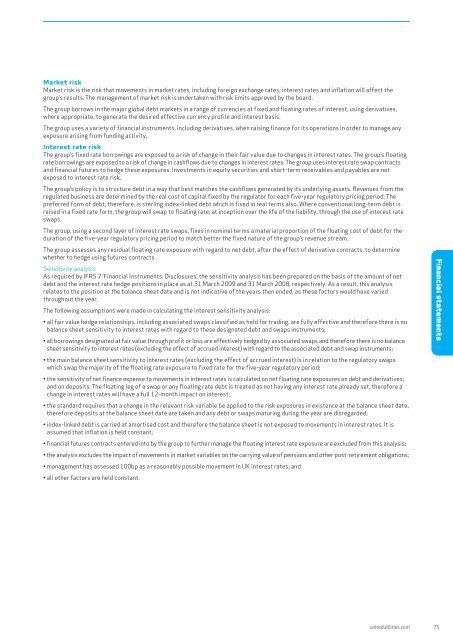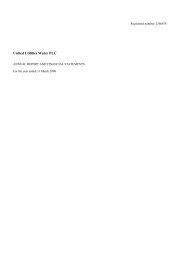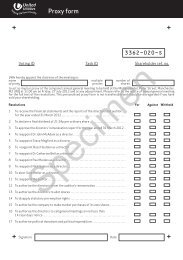Annual report and financial statement 2009 - United Utilities
Annual report and financial statement 2009 - United Utilities
Annual report and financial statement 2009 - United Utilities
Create successful ePaper yourself
Turn your PDF publications into a flip-book with our unique Google optimized e-Paper software.
Market riskMarket risk is the risk that movements in market rates, including foreign exchange rates, interest rates <strong>and</strong> inflation will affect thegroup’s results. The management of market risk is undertaken with risk limits approved by the board.The group borrows in the major global debt markets in a range of currencies at fixed <strong>and</strong> floating rates of interest, using derivatives,where appropriate, to generate the desired effective currency profile <strong>and</strong> interest basis.The group uses a variety of <strong>financial</strong> instruments, including derivatives, when raising finance for its operations in order to manage anyexposure arising from funding activity.Interest rate riskThe group’s fixed rate borrowings are exposed to a risk of change in their fair value due to changes in interest rates. The group’s floatingrate borrowings are exposed to a risk of change in cashflows due to changes in interest rates. The group uses interest rate swap contracts<strong>and</strong> <strong>financial</strong> futures to hedge these exposures. Investments in equity securities <strong>and</strong> short-term receivables <strong>and</strong> payables are notexposed to interest rate risk.The group’s policy is to structure debt in a way that best matches the cashflows generated by its underlying assets. Revenues from theregulated business are determined by the real cost of capital fixed by the regulator for each five-year regulatory pricing period. Thepreferred form of debt, therefore, is sterling index-linked debt which is fixed in real terms also. Where conventional long-term debt israised in a fixed rate form, the group will swap to floating rate, at inception over the life of the liability, through the use of interest rateswaps.The group, using a second layer of interest rate swaps, fixes in nominal terms a material proportion of the floating cost of debt for theduration of the five-year regulatory pricing period to match better the fixed nature of the group’s revenue stream.The group assesses any residual floating rate exposure with regard to net debt, after the effect of derivative contracts, to determinewhether to hedge using futures contracts.Sensitivity analysisAs required by IFRS 7 ‘Financial Instruments: Disclosures’, the sensitivity analysis has been prepared on the basis of the amount of netdebt <strong>and</strong> the interest rate hedge positions in place as at 31 March <strong>2009</strong> <strong>and</strong> 31 March 2008, respectively. As a result, this analysisrelates to the position at the balance sheet date <strong>and</strong> is not indicative of the years then ended, as these factors would have variedthroughout the year.The following assumptions were made in calculating the interest sensitivity analysis:• all fair value hedge relationships, including associated swaps classified as held for trading, are fully effective <strong>and</strong> therefore there is nobalance sheet sensitivity to interest rates with regard to these designated debt <strong>and</strong> swaps instruments;• all borrowings designated at fair value through profit or loss are effectively hedged by associated swaps <strong>and</strong> therefore there is no balancesheet sensitivity to interest rates (excluding the effect of accrued interest) with regard to the associated debt <strong>and</strong> swap instruments;• the main balance sheet sensitivity to interest rates (excluding the effect of accrued interest) is in relation to the regulatory swapswhich swap the majority of the floating rate exposure to fixed rate for the five-year regulatory period;• the sensitivity of net finance expense to movements in interest rates is calculated on net floating rate exposures on debt <strong>and</strong> derivatives;<strong>and</strong> on deposits. The floating leg of a swap or any floating rate debt is treated as not having any interest rate already set, therefore achange in interest rates will have a full 12-month impact on interest;• the st<strong>and</strong>ard requires that a change in the relevant risk variable be applied to the risk exposures in existence at the balance sheet date,therefore deposits at the balance sheet date are taken <strong>and</strong> any debt or swaps maturing during the year are disregarded;• index-linked debt is carried at amortised cost <strong>and</strong> therefore the balance sheet is not exposed to movements in interest rates. It isassumed that inflation is held constant;• <strong>financial</strong> futures contracts entered into by the group to further manage the floating interest rate exposure are excluded from this analysis;• the analysis excludes the impact of movements in market variables on the carrying value of pensions <strong>and</strong> other post-retirement obligations;• management has assessed 100bp as a reasonably possible movement in UK interest rates; <strong>and</strong>• all other factors are held constant.Financial <strong>statement</strong>sunitedutilities.com 75
















